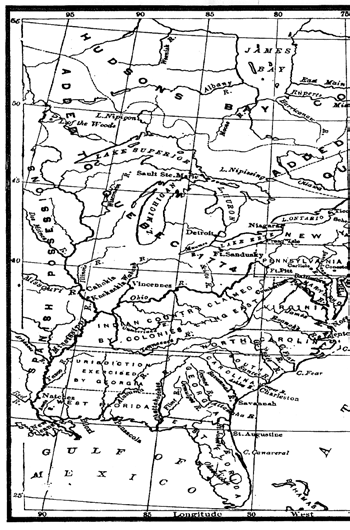CHAPTER 2: THE COLONIAL PERIOD
AN EXCEPTIONAL NATION?
The United States of America did not emerge as a nation until about 175
years after its establishment as a group of mostly British colonies. Yet from the beginning it was a different society in the eyes of many Europeans who viewed
it from afar, whether with hope or apprehension. Most of its settlers — whether the younger sons of aristocrats, religious dissenters, or impoverished indentured servants — came there lured by a promise of opportunity or freedom not
available in the Old World. The first Americans were reborn free, establishing themselves in a wilderness unencumbered by any social order other than that
of the primitive aboriginal peoples they displaced. Having left the baggage of a feudal order behind them, they faced few obstacles to the development of a
society built on the principles of political and social liberalism that emerged with difficulty in 17th- and 18th-century Europe. Based on the thinking of the philosopher John Locke, this sort of liberalism emphasized the rights of the
individual and constraints on government power.
Most immigrants to America came from the British Isles, the most
liberal of the European polities along with The Netherlands. In religion, the
majority adhered to various forms of Calvinism with its emphasis on both
divine and secular contractual relationships. These greatly facilitated the
emergence of a social order built on individual rights and social mobility. The development of a more complex and highly structured commercial society in
coastal cities by the mid-18th century did not stunt this trend; it was in these cities that the American Revolution was made. The constant reconstruction
of society along an ever-receding Western frontier equally contributed to a
liberal-democratic spirit.
In Europe, ideals of individual rights advanced slowly and unevenly; the
concept of democracy was even more alien. The attempt to establish both in
continental Europe’s oldest nation led to the French Revolution. The effort to destroy a neofeudal society while establishing the rights of man and democratic fraternity generated terror, dictatorship, and Napoleonic despotism. In the end, it led to reaction and gave legitimacy to a decadent old order. In America, the European past was overwhelmed by ideals that sprang naturally from the
process of building a new society on virgin land. The principles of liberalism and democracy were strong from the beginning. A society that had thrown off
the burdens of European history would naturally give birth to a nation that
saw itself as exceptional.
34
OUTLINE OF U.S. HISTORY
THE WITCHES OF SALEM
In 1692 a group of adolescent girls in Salem Village, Massachusetts, became subject to strange fits after hearing tales told by a West Indian slave. They
accused several women of being witches. The townspeople were appalled but
not surprised: Belief in witchcraft was widespread throughout 17th-century
America and Europe. Town officials convened a court to hear the charges of
witchcraft. Within a month, six women were convicted and hanged.
The hysteria grew, in large measure because the court permitted wit-
nesses to testify that they had seen the accused as spirits or in visions. Such
“spectral evidence” could neither be verified nor made subject to objective
examination. By the fall of 1692, 20 victims, including several men, had been
executed, and more than 100 others were in jail (where another five victims
died) — among them some of the town’s most prominent citizens. When the
charges threatened to spread beyond Salem, ministers throughout the colony
called for an end to the trials. The governor of the colony agreed. Those still in jail were later acquitted or given reprieves.
Although an isolated incident, the Salem episode has long fascinated
Americans. Most historians agree that Salem Village in 1692 experienced a
kind of public hysteria, fueled by a genuine belief in the existence of witch-
craft. While some of the girls may have been acting, many responsible adults
became caught up in the frenzy as well.
Even more revealing is a closer analysis of the identities of the ac-
cused and the accusers. Salem Village, as much of colonial New England,
was undergoing an economic and political transition from a largely agrarian,
Puritan-dominated community to a more commercial, secular society. Many
of the accusers were representatives of a traditional way of life tied to farming and the church, whereas a number of the accused witches were members of a
rising commercial class of small shopkeepers and tradesmen. Salem’s obscure
struggle for social and political power between older traditional groups and a newer commercial class was one repeated in communities throughout American history. It took a bizarre and deadly detour when its citizens were swept
up by the conviction that the devil was loose in their homes.
The Salem witch trials also serve as a dramatic parable of the deadly
consequences of making sensational, but false, charges. Three hundred years
later, we still call false accusations against a large number of people a
“witch hunt.”
35





